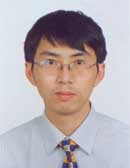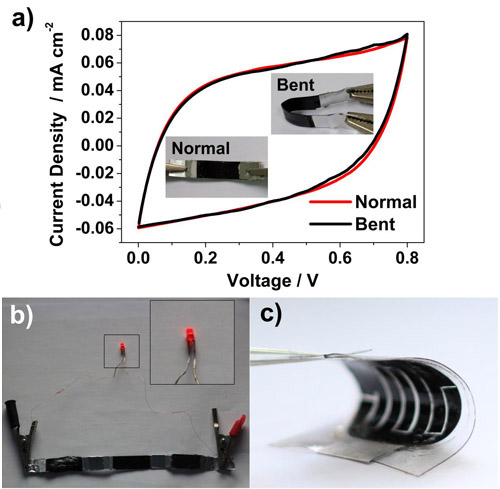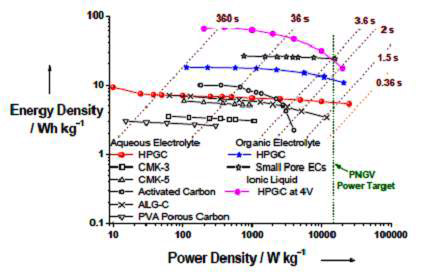
-
LI Feng Title:Professor Email: fli@imr.ac.cn Tel. : +86-24-23971472 FAX: +86-24-23903126 Division: Shenyang National Laboratory for Materials Science Address: Advanced Carbon Division, Institute of Metal Research Chinese Academy of Sciences (IMR CAS), 72 Wenhua Road, Shenyang, China, 110016
Experience: |
|
Ph.D.: Materials Science, IMR, CAS (Sept. 1998-Jun. 2001). M.S. in Physics and chemistry of materials, IMR, CAS (Sept. 1995-Jul 1998) B.S. in Application Chemistry, Nanjing institute of Chemical engineering 1991-1995 (Now Name: Nanjing University of Technology)
Oct. 2008-present Professor at IMR, CAS Apr. 2004-Sep. 2008 Associate Professor at IMR, CAS Jun 2001-2004 Mar. Research Associate at IMR, CAS |
Research Interest: |
|
Novel carbon based materials for lithium ion batteries, lithium sulfur battery and supercapacitors |
Research Achievement: |
|
Graphene based flexible energy storage devices Energy storage devices, such as batteries and supercapacitors, are the essential parts of portable electronic products. With the miniaturized, wearable and flexible electronic products coming, there is a strong demand for the development of light-weight, thin and flexible energy storage devices. Electrode materials with high capacitance and mechanical property are the key factor. Therefore, we develop the process to fabricate a flexible electrode using graphene membrane with polyanilne by electropolymerization for supercapacitors, which show the promising performance. In order to improve mechanical flexibility and electrochemical properties, we prepare a graphene-cellulose paper composite material, which consists of a unique three-dimensional interwoven structure of graphene and cellulose fibers. The composite paper inherits the superior flexibility of cellulose paper. Moreover, the cellulose fibers can not only serve as a high-speed way to facilitate the transport of electrolyte ions, also prevent the agglomeration of graphene. Benefiting from the above characteristics, supercapacitors based on the composite paper show superior mechanical flexibility and excellent power performance. Several kinds of thin, lightweight and flexible membrane supercapacitors with various architectures are assembled to meet the power-energy requirements of typical flexible or printable electronics. Due to the technology developed by our group for large scale preparation of graphene with low cost and the simple method to fabricate the graphene-cellulose paper, the paper have great potential applications for flexible electronic products.
Figure a) Comparison of cycle voltammetry curves for a flexible supercapacitor based on graphene-cellulose paper tested in the normal and bent condition. b) Photograph of a red light emitting diode lighted by an in-series supercapacitors with three units. c) Photograph of a flexible interdigital supercapacitor based on graphene-cellulose paper. Design of Hierarchical Porous Graphitic Carbon for high power density energy storage applications The application of porous carbon in the electrochemical capacitors (ECs) is obsessed by kinetic problems related with inner-pore ion transport and electric conductivity, especially for those applications requiring high rate operations. The inner-pore kinetic problems are mainly referred as high ion transport resistance and long diffusion distance in a porous electrode. To improve the electrochemical kinetic processes of a porous electrode, we designed and synthesized a novel hierarchical porous graphitic carbon (HPGC) material by liquid inorganic template approach using reactive template. Firstly, we created 3D self-supporting texture of macroporous cores as ion-buffering reservoirs to shorten the diffusion distance of inner-pore ion transport. Secondly, mesoporous walls are produced around those macroporous cores to minimize the inner-pore resistance of ion transport. Thirdly, we introduced localized graphitic structures into the electrode carbon material to enhance its electric conductivity. The HPGC material was examined for high rate electrochemical capacitive energy storage, and in comparison with different types of porous carbons, and it exhibited the best performance, especially with operation time less than 2 s. This HPGC material shows power density exceeding the PNGV (Partnership for a New Generation of Vehicle) power target and is applicable for advanced ECs with either aqueous or organic electrolytes.
Fig. Ragone plot of HPGC material in aqueous and organic electrolyte |
Service to the International Professional Societies: |
Honors: |
Publication: |
|
1. G. M. Zhou, D. W. Wang, F. Li,* P. X. Hou, L. C. Yin, C. Liu, G. Q. Lu, I. R. Gentle, H. M. Cheng*, A flexible nanostructured sulphur–carbon nanotube cathode with high rate performance for Li-S batteries, Energy & Environmental Science, DOI: 10.1039/c2ee22294a 2. G. M. Zhou, D. W. Wang, P. X. Hou, W. S. Li, N. Li, C. Liu, F. Li*, H. M. Cheng, A nanosized Fe2O3 decorated single-walled carbon nanotube membrane as a high-performance flexible anode for lithium ion batteries, Journal of Materials Chemistry 22 (34), 17942-17946, (2012) 3. D. W. Wang, G. M. Zhou, F. Li, K. H. Wu, G. Q. Lu, H. M. Cheng*, I. R. Gentle*, A microporous-mesoporous carbon with graphitic structure for a high-rate stable sulfur cathode in carbonate solvent-based Li-S batteries, Physical Chemistry Chemical Physics 14 (24), 8703-8710, (2012). 4. G. M. Zhou, D. W. Wang, X. Y. Shan, N. Li, F. Li*, H. M. Cheng, Hollow carbon cage with nanocapsules of graphitic shell/nickel core as an anode material for high rate lithium ion batteries, Journal of Materials Chemistry 22 (22), 11252-11256, (2012). 5. W. J. Yu, P. X. Hou, F. Li, C. Liu*, Improved electrochemical performance of Fe2O3 nanoparticles confined in carbon nanotubes, Journal of Materials Chemistry 22 (27), 13756-13763, (2012). 6. D. W. Wang, F. Li*, L. C. Yin, X. Lu, Z. G. Chen, I. R. Gentle, G. Q. Lu, H. M. Cheng*, Nitrogen-doped carbon monolith for alkaline supercapacitors and understanding nitrogen-induced redox transitions, Chemistry-A European Journal 18 (17), 5345-5351, (2012). 7. G. M. Zhou, D. W. Wang, L. C. Yin, N. Li, F. Li*, H. M. Cheng, Oxygen bridges between NiO nanosheets and graphene for improvement of lithium storage, ACS Nano 6 (4), 3214-3223, (2012). 8. N. Li, G. Liu, C. Zhen, F. Li*, L. L. Zhang, H. M. Cheng*, Battery Performance and Photocatalytic Activity of Mesoporous Anatase TiO2 Nanospheres/Graphene Composites by Template-Free Self-Assembly, Advanced Functional Materials 21 (9), 1717-1722, (2011). 9. F. Xu, R. J. Cai, Q. C. Zeng, C. Zou, D. C. Wu*, F. Li, X. E. Lu, Y. R. Liang, R. W. Fu, Fast ion transport and high capacitance of polystyrene-based hierarchical porous carbon electrode material for supercapacitors, Journal of Materials Chemistry 21 (6), 1970-1976, (2011). 10. Z. Weng, Y. Su, D. W. Wang, F. Li, J. H. Du, H. M. Cheng*, Graphene-cellulose paper flexible supercapacitors, Advanced Energy Materials 1 (5), 917-922, (2011). 11. Y. Shi, L. Wen, F. Li*, H. M. Cheng, Nanosized Li4Ti5O12/graphene hybrid materials with low polarization for high rate lithium ion batteries, Journal of Power Sources 196 (20), 8610-8617, (2011). 12. C. Liu, F. Li, L. P. Ma, H. M. Cheng*, Advanced materials for energy storage, Advanced Materials 22 (8), E28-E62, (2010). 13. Z. S. Wu, D. W. Wang, W. C. Ren*, J. P. Zhao, G. M. Zhou, F. Li, H. M. Cheng*, Anchoring hydrous RuO2 on graphene sheets for high-performance electrochemical capacitors, Advanced Functional Materials 20 (20), 3595-3602, (2010). 14. Z. S. Wu, W. C. Ren*, L. Wen, L. B. Gao, J. P. Zhao, Z. P. Chen, G. M. Zhou, F. Li, H. M. Cheng*, Graphene anchored with Co3O4 nanoparticles as anode of lithium ion batteries with enhanced reversible capacity and cyclic performance, ACS Nano 4 (6), 3187-3194, (2010). 15. G. M. Zhou, D. W. Wang, F. Li*, L. L. Zhang, N. Li, Z. S. Wu, L. Wen, G. Q. Lu, H. M. Cheng*, Graphene-wrapped Fe3O4 anode material with improved reversible capacity and cyclic stability for lithium ion batteries, Chemistry of Materials 22 (18), 5306-5313, (2010). 16. Z. S. Wu, W. C. Ren*, D. W. Wang, F. Li, B. L. Liu, H. M. Cheng*, High-energy MnO2 nanowire/graphene and graphene asymmetric electrochemical capacitors, ACS Nano 4 (10), 5835-5842, (2010). 17. W. J. Yu, P. X. Hou, L. L. Zhang, F. Li, C. Liu*, H. M. Cheng, Preparation and electrochemical property of Fe2O3 nanoparticles-filled carbon nanotubesw, Chemical Communications, 46 (45), 8576-8578, (2010). 18. D. W. Wang, F. Li*, Z. S. Wu, W. C. Ren, H. M. Cheng*, Electrochemical interfacial capacitance in multilayer graphene sheets: Dependence on number of stacking layers, Electrochemistry Communications 11 (9), 1729-1732, (2009). 19. D. W. Wang, F. Li, J. P. Zhao, W. C. Ren, Z. G. Chen, J. Tan, Z. S. Wu, I. Gentle, G. Q. Lu, H. M. Cheng*, Fabrication of graphene/polyaniline composite paper via in situ anodic electropolymerization for high-performance flexible electrode, ACS Nano 3 (7), 1745-1752, (2009). 20. D. W. Wang, F. Li, M. Liu, G. Q. Lu, H. M. Cheng*, 3D aperiodic hierarchical porous graphitic carbon material for high-rate electrochemical capacitive energy storage, Angewandte Chemie-International Edition 47 (2), 373-376, (2008). 21. C. G. Liu, M. Liu, F. Li, H. M. Cheng*, Frequency response characteristic of single-walled carbon nanotubes as supercapacitor electrode material, Applied Physics Letters 92 (14), 143108, (2008). 22. D. W. Wang, F. Li, H. M. Cheng*, Hierarchical porous nickel oxide and carbon as electrode materials for asymmetric supercapacitor, Journal of Power Sources 185 (2), 1563-1568, (2008). 23. D. W. Wang, F. Li, M. Liu, G. Q. Lu, H. M. Cheng*, Mesopore-aspect-ratio dependence of ion transport in rodtype ordered mesoporous carbon, Journal of Physical Chemistry C 112 (26), 9950-9955, (2008). 24. D. W. Wang, H. T. Fang, F. Li, Z. G. Chen, Q. S. Zhong, G. Q. Lu, H. M. Cheng*, Aligned titania nanotubes as an intercalation anode material for hybrid electrochemical energy storage, Advanced Functional Materials,18 (23), 3787-3793,2008 25. H. L. Zhang, F. Li, C. Liu, H. M. Cheng*, Poly (vinyl chloride) (PVC) coated idea revisited: Influence of carbonization procedures on PVC-coated natural graphite as anode materials for lithium ion batteries, Journal of Physical Chemistry C 112 (20), 7767-7772, (2008). 26. D. W. Wang, F. Li, G. Q. Lu, H. M. Cheng*, Synthesis and dye separation performance of ferromagnetic hierarchical porous carbon, Carbon 46 (12), 1593-1599, (2008). 27. D. W. Wang, F. Li, Z. G. Chen, G. Q. Lu, H. M. Cheng*, Synthesis and electrochemical property of boron-doped mesoporous carbon in supercapacitor, Chemistry of Materials 20 (22), 7195-7200, (2008). |
Homepage: |


